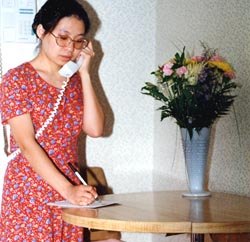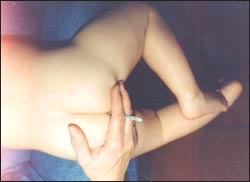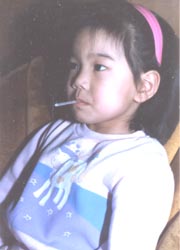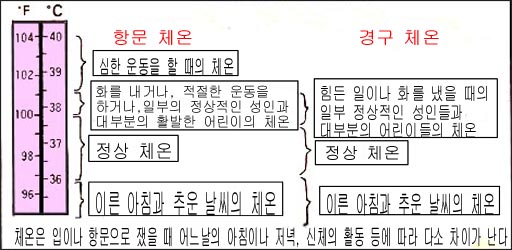신생아들에게 열을 나게 하는 원인, Causes of Fever in newborn infants

사진 12. 신생아에게 열이 나면 즉시 의사에게 문의하던지 병원 응급실로 바로 데리고 간다.
Copyright ⓒ 2011 John Sangwon Lee, MD., FAAP

사진 13. 즉시 의사에게 문의하던지 병원 응급실로 바로 데리고 간다.
Copyright ⓒ 2011 John Sangwon Lee, MD., FAAP
- 태어나서부터 생후 28일까지 기간을 신생아기라 하고 그 기간의 아기들을 신생아들 이라고 한다.
- 생후 2~3일 경 감염병이 없는 신생아에게 생긴 탈수로 열이 날 수 있다.
- 이 때 신생아가 모유나 인공영양을 충분히 섭취하지 못하고, 생리적 체중감소로 열이 날 수 있다. 이렇게 생긴 열을 신생아 탈수열이라 한다.
- 신생아가 신생아 탈수열 이외 다른 원인으로 탈수되면서 체온이 낮아지기도 하고 체온이 올라가서 고열이 날 수 있다. 이렇게 나는 열은 신생아 탈수열이라 하지 않는다.
- 부모도 반의사가 되어야 한다-소아 가정간호백과 제 6권 신생아 성장, 발육, 양호 및 질병-신생아 탈수열 참조.
- 신생아에게 생긴 선천성 바이러스성 감염병, 후천성 바이러스성 감염병, 또는 박테리아성 감염병 등으로 신생아에게 열이 날 수 있다.
- 신생아에게 생긴 감염병으로 열이 나고 탈수될 수 있다. 신생아 생리적 탈수열과 감별 진단해야 한다.
- 감염병을 앓고 있지 않은 건강한 신생아에게 너무 옷을 많이 입히거나 아기를 두꺼운 담요 로 너무 많이 싸주면 신생아의 체온이 올라가고 열이 날 수 있다.
- 보육기 내 온도나 실내 온도가 보통 이상으로 상당히 높으면 신생아의 체온이 비정상적으로 많이 올라가고 열이 날 수 있다.
- 생후 28일 이전 신생아의 체온이 화씨 100.4° 이상 더 높거나 섭씨 38° 이거나 그 이상이 면 열이 난다고 진단할 수 있다. 미소아과 학회는 병원에 입원을 시키고 열나는 원인을 찾으면서 적절한 치료를 시작하라고 권장한다.
영아들에게 열을 나게 하는 원인 Causes of fever in infants

사진 14. 열이 난다고 의심되면 체온을 잰다. 체온을 잰 후 손을 깨끗이 씻는다
Copyright ⓒ 2011 John Sangwon Lee, MD., FAAP
- 생후 29일에서 1세까지 기간을 영아기 또는 유아기(乳兒期)라 하고 그 기간의 아기들을 유아(乳兒)들 또는 영아들이라고 한다.
- 영아들에게 바이러스성 감염으로 생긴
- 상·하기도 감염병 및, 또는 바이러스성 감염으로 생긴 하기도 감염병,
- 바이러스성 후두염,
- 바이러스성 기관지염,
- 박테리아성 중이염,
- 박테리아성 편도염이나
- 바이러스성 편도염이나 인두염,
- 또는 폐렴 등으로 열이 날 수 있다.
- 바이러스성 위장염,
- 박테리아성 위장염 등으로 열이 날 수 있다.
- 요로 감염으로 열이 날 수 있다. 요로 감염으로 열이 여러 날 동안 계속 날 수 있고 며칠 동안은 열이 났다가 며칠 동안은 열이 안 났다, 또 그런 식으로 열이 여러 날 나기도 한다.
- 예방접종 백신으로 접종 받은 후 열이 날 수 있다.
- 그밖에 , 류마티스 열,
- 류마티스 관절염,
- 연소성 류마티스양 관절염,
- 백혈병,
- 악성 종양,
- 가와사키 병,
- 전신성 다형 홍반 등으로 열이 날 수 있다.
유아들에게 열을 나게 하는 원인 Fever in toddlers and preschool children

사진 15. 열이 난다고 의심되면 체온을 잰다.
Copyright ⓒ 2011 John Sangwon Lee, MD., FAAP
- 1세부터 6세까지의 기간을 유아기라 하고 그 기간의 아이들을 유아(幼兒)들이라고 한다.
- 유아들 중 1~3세 연령층의 유아들을 토들러(Toddlers)라하고 3~6세 유아들을 학령기 전 유아들 이라 한다.
- 이 시기의 유아들에게 나는 열의 원인의 대부분은 바이러스성 상기도 감염염 또는 바이러스성 하기도 감염병이다.
- 즉 바이러스 감염으로 인한 감기, 비염, 편도염, 인두염, 인두편도염, 후두염, 기관지염, 세기관지염 등으로 열이 날 수 있다.
- 홍역,
- 풍진,
- 수두,
- 돌발성 발진(장미진) 등 전신성 바이러스성 감염병으로 열이 날 수 있다.
- 박테리아 감염으로 인한 요로 감염병이나
- 박테리아 감염병으로 인한 위장염으로 열이 날 수 있고
- 바이러스성 위장염으로도 열이 날 수 있다.
- 그 외 박테리아성 뇌막염,
- 바이러스성 뇌막염,
- 박테리아성 이하선염
- 바이러스성 이하선염,
- 박테리아성 관절염,
- 바이러스성 관절염 등으로 열이 날 수 있다.
- A군 β 용혈성 연쇄상구균 감염에 의한 편도염이나 인두편도염으로 열이 날 수 있다.
- 3세 이전 영유아들에게는 A군 β 용혈성 연쇄상구균 감염으로 인한 편도염, 인두염 또는 인두 편도염은 잘 생기지 않는다.
- 3세 이전 영유아들의 편도염이나 인두염의 거의가 A군 β 용혈성 연쇄상구균 감염으로 생기지 않고 바이러스 감염병으로 생긴다.
- 그밖에 도 약물로 인한 열,
- 백혈병,
- 악성종양,
- 결합조직 질환,
- 자가 면역 질환,
- 가와사키 병 등으로 열이 날 수 있다.
학령기 아이들과 사춘기 아이들에게 열을 나게 하는 원인 Causes of fever in school children and adolescents

사진 16. 열이 난다고 의심되면 체온을 잰다.
Copyright ⓒ 2001 John Sangwon Lee, MD, FAAP
- 6세에서 10~12세까지 기간을 학령기라 하고 그 기간의 아이들을 학령기 아이들이라고 한다.
- 학령기 아이들에게 나는 열의 원인의 대부분은 학령기 전 유아기의 아이들에게 나는 열의 원인과 거의 같다.
- 바이러스성 편도염,
- 바이러스성 인두염,
- 바이러스성 후두염,
- 바이러스성 기관지염 등으로 열이 난다.
- 바이러스 감염이나 박테리아 감염으로 인한 폐렴,
- A군 β 용혈성 연쇄상구균 감염으로 인한 인두염이나 인두편도염 등으로 열이 날 수 있다.
- 박테리아 감염으로 인한 요로 감염,
- 박테리아성 위장염,
- 바이러스성 위장염으로 열이 날 수 있다.
- 바이러스성 뇌막염이나
- 박테리아성 뇌막염,
- 박테리아성 이하선염
- 바이러스성 이하선염,
- 바이러스성 간염,
- 수족구병,
- 전염성 단핵구증(모노) 등 감염병으로 열이 날 수 있다.
- 드물게 약물 부작용,
- 예방접종 백신 부작용,
- 알레르기 질환,
- 류마티스 열, 류마티스성 관절염,
- 연소성 류마토이드 관절염,
- 백혈병,
- 악성 종양,
- 가와사키 병,
- 전신 다형 홍반 등으로 열이 날 수 있다.
- 사춘기 아이들에게 생기는 열의 원인은 학령기 아이들에게 생기는 열의 원인과 거의 같다.
아이에게 열이 나는지 어떻게 알 수 있나 How to know your child has fever
- 어린 자녀에게 열이 난다고 걱정하면서 어떻게 했으면 좋겠느냐고 소아청소년과에 전화 상담진료하면서 걱정하는 부모들이 많다.
- 어느 정도로 열이 나느냐고 물으면 모른다고 답한다. ‘열나는지 어떻게 아느냐“고 물으면 “이마를 만져보니까 뜨거워서 열이 난다고 생각합니다.”라고 대답한다.
- 물론 아이의 이마를 엄마 손으로 만져보고 열이 나는지 안 나는지 어느 정도 알 수 있다.
- 몸이 불덩이 같이 뜨겁고 덜덜 떨면서 열이 나는 것 같다고 하는 부모도 있다.
- 사실 그 말은 거의 맞는 말이다.
- 연구에 의하면 부모가 손으로 아이의 이마나 몸을 만져서 열이 나는 것 같아서 체온을 재보면 실제로 열이 안 나는 경우가 25~50%가 된다고 한다.
- 추워서 덜덜 떨고 한전이 나고 몹시 아픈 것 같고 몸이 불덩이 같으면 체온을 재지 않고 열이 난다는 것을 쉽게 알 수 있다.
- 그러나 열이 잠시 동안 나다가 안 나고 또다시 열이 났다가 안 나면서 앓거나, 열이 나지만 잘 먹고 잘 뛰고 놀면서 경하게 앓을 때 체온을 재지 않으면 열이 정말로 나는지 모르고 얼마 동안 그냥 지낼 수 있다.
- 소아청소년 자녀가 어떤 원인으로 앓을 때는 물론이고 다음과 같은 경우에는 체온을 재어 열이 나는지 알아보고 어떤 병으로 열이 나는지 확실히 알아서 적절한 치료를 하는 것이 좋다.
다음과 같은 경우 열이 나나 의심해 볼 수 있다.
① 몸이 뜨겁고 피부가 건조할 때
② 땀이 비정상적으로 많이 날 때
③ 피부에 발진이 날 때
④ 얼굴이 창백하거나 붉을 때
⑤ 비정상적으로 숨을 빨리 쉬거나 느리게 쉬거나 숨소리가 이상하거나 숨을 힘들여 쉴 때
⑥ 콧물이 나고 재채기를 하거나 기침 하고 목이 쉴 때
⑦ 잘 먹지 않거나 아픈 것 같이 보일 때
⑧ 구토, 설사 할 때, 또는 구토와 설사를 동시에 할 때
⑨ 비정상적으로 잠을 많이 자거나 조금 잘 때
⑩ 보통 때와 같이 잘 놀지 않고 보채거나 많이 울 때
⑪ 머리나 팔다리가 아플 때
⑫ 배가 아플 때
⑬ 인두가 아플 때
⑭ 소변을 자주 보거나 소변을 볼 때 아프거나 소변에 피가 나올 때
⑮ 그 외
표 열이 나는지 안 나는지 확실히 알기 위해서는 체온을 재어야한다.

그림 17. 여러 조건에 따라 정상적으로 체온이 변할 수 있다. 소스: 제21권 소아청소년 가정 ․학교 간호 참조문헌 및 출처-3.
Causes of fever for different ages
Causes of Fever in newborn infants

- Photo 12.
- If the newborn has a fever, ask a doctor immediately or take it directly to the hospital emergency room.
- Copyright ⓒ 2011 John Sangwon Lee, MD., FAAP

Photo 13. Immediately ask a doctor or take it directly to the hospital emergency room.
- Copyright ⓒ 2011 John Sangwon Lee, MD., FAAP
- The period from birth to 28 days of age is called the newborn period, and babies during that period are called newborns.
- Around 2-3 days after birth, a fever can occur due to dehydration that occurs in newborns who do not have an infectious disease.
- At this time, the newborn cannot consume enough breast milk or artificial nutrition, and physiological weight loss can cause fever.
- This fever is called newborn dehydration fever.
- As newborns are dehydrated for causes other than newborn dehydration fever, their body temperature may decrease, and body temperature may rise, resulting in a high fever.
- This fever is not called newborn dehydration fever. Parents should also be at least a half doctors-see Encyclopedia of Pediatric Home Nursing, Volume 6, Newborn Growth, Development, Good Health and Disease-Newborn Dehydration. Newborn babies can get fever due to congenital viral infections, acquired viral infections, or bacterial infections.
- It is an infectious disease in newborns that can lead to fever and dehydration. Newborns should be diagnosed differentially from physiological dehydration fever. Too much clothing for a healthy newborn who does not have an infectious disease or wrapping the baby too much in a thick blanket can raise the newborn’s body temperature and create a fever.
- If the temperature in the incubator or in the room is significantly higher than normal, the newborn’s body temperature may rise abnormally and cause a fever. A newborn baby’s body temperature before 28 days of age can be diagnosed as having a fever if it is 100.4°F or higher or 38°C or higher.
- The Academy of Microsurgery recommends that you be admitted to a hospital and initiate appropriate treatment while looking for the cause of the fever.
Causes of fever

Photo 14.
If you suspect you have a fever, take your temperature. Wash your hands thoroughly after taking your body temperature Copyright ⓒ 2011 John Sangwon Lee, MD., FAAP
- The period from 29 days to 1-year-old is called infancy, and babies during that period are called infants.
- Caused by viral infections in infants
- Upper and lower respiratory tract infections caused by viral infections,
- Viral laryngitis,
- Viral bronchitis,
- Bacterial otitis media,
- Bacterial tonsillitis or
- Viral tonsillitis or pharyngitis,
- Or, they may have a fever due to pneumonia.
- Viral gastroenteritis,
- Bacterial gastroenteritis can cause fever.
- A urinary tract infection can cause fever.
- A urinary tract infection can cause a fever to continue for many days, a fever for several days, no fever for several days, and so on for several days.
- Vaccination You may have a fever after being vaccinated with the vaccine.
- In addition, rheumatic fever,
- Rheumatoid arthritis,
- Juvenile rheumatoid arthritis,
- leukemia,
- Malignant tumor,
- Kawasaki disease,
- Systemic polymorphic erythema can cause fever.
- Fever in toddlers and preschool children temperature

Picture 15. If you suspect you have a fever, take your temperature. Copyright ⓒ 2011 John Sangwon Lee, MD., FAAP
- The period from 1 to 6 years old is called toddlers, and preschool children.
- Among the children aged 1 to 3 are called Toddlers, and the children aged 3 to 6 are called preschool children.
- Most of the causes of fever in children during this period are viral upper respiratory tract infections or viral lower respiratory tract infections.
- In other words, fever may occur due to cold, rhinitis, tonsillitis, pharyngitis, pharyngitis tonsillitis, laryngitis, bronchitis, bronchiolitis, etc. due to viral infection. Measles, German measles, varicella, systemic viral infections such as a sudden rash (rose rash) can cause fever.
- Urinary tract infections caused by bacterial infections or Gastroenteritis caused by bacterial infectious diseases can cause fever
- Viral gastroenteritis can also cause fever.
- Other bacterial meningitis, Viral meningitis, Bacterial parotitis, Viral mumps, Bacterial arthritis, Viral arthritis can cause fever.
- Group A β Hemolytic streptococcal infection can cause tonsillitis or pharyngeal tonsillitis.
- Tonsillitis,
- pharyngitis,
- or pharyngeal tonsillitis due to group A β hemolytic streptococcal infection are not common in infants and young children before 3 years of age.
- Most of tonsillitis and pharyngitis of infants and young children before the age of 3 do not occur due to group A β hemolytic streptococcal infection, but due to viral infections.
- In addition, fever caused by drugs, leukemia,
- Malignant Tumor,
- Connective tissue diseases,
- Autoimmune diseases,
- Kawasaki disease can cause fever.
Causes of fever in school children and adolescents

Picture 16. If you suspect your child has a fever, take your temperature.
- Copyright ⓒ 2001 John Sangwon Lee, MD, FAAP
- The period from 6 ~10 to 12 years old is called school-age, and children during that period are called school-age children.
- Most of the causes of fever in school-age children are almost the same as those in preschool children.
- Viral tonsillitis,
- Viral pharyngitis,
- Viral laryngitis,
- You have a fever due to viral bronchitis.
- Pneumonia caused by a viral or bacterial infection,
- Group A, the β-Hemolytic streptococcal infection can cause fever due to pharyngitis or pharyngeal tonsillitis.
- Urinary tract infections due to bacterial infections,
- Bacterial gastroenteritis,
- Viral gastroenteritis can cause fever.
- Viral meningitis
- Bacterial meningitis,
- Bacterial parotitis
- Viral parotitis,
- Viral hepatitis,
- Hand, Foot and Mouth Disease,
- Infectious diseases such as infectious mononucleosis (mono) can cause fever. Rarely drug side effects,
- Vaccination vaccine side effects,
- Allergic diseases,
- Rheumatic fever,
- Rheumatoid arthritis,
- Juvenile rheumatoid arthritis,
- Leukemia,
- Malignant tumor,
- Kawasaki disease,
- Fever can be caused by systemic polymorphic erythema.
- The cause of fever in adolescent children is almost the same as the cause of fever in school-age children.
How to know your child has a fever
- There are many parents who worry about having a fever in their younger children and worry about what to do with the phone consultation at the Department of Children and Adolescents.
- When asked how much fever they have, they answer that they don’t know.
- When asked, “How do you know if you’re hot,” you answer, “I think it’s hot when I touch my forehead.”
- Of course, by touching the child’s forehead with the mother’s hand, you can know to some extent whether or not the child has a fever.
- Some parents say that their bodies are hot as a fireball, and they seem to be getting a fever while shaking.
- In fact, that’s pretty much correct. According to research, parents seem to know whether they children have or not fever by touching their forehead or body with their hands, so when they measure their body temperature, 25-50% of them actually do not have a fever.
- It’s easy to know that you’re getting a fever without measuring your body temperature if you feel cold, trembling, have a cold, and feel very sick, and your body is like a fireball.
- However, if you do not measure your body temperature when you have a fever but are sick with a fever after not having a fever for a while and then do not have a fever again, or if you have a fever but eat well and run and play and are mildly ill, you can stay without knowing if you really have a fever.
- When children and adolescents suffer from what causes, as well as in the following cases, it is good to measure the body temperature to find out if the fever is generated, and to know exactly which disease causes the fever to be treated appropriately.
A fever or suspicion can be suspected in the following cases:
① When the body is hot and the skin is dry
② When sweating is abnormally heavy
③ When there is a rash on the skin
④ When the face is pale or red
⑤ When you breathe abnormally quickly or slowly, when you breathe abnormally, or when you have difficulty breathing
⑥ When you have a runny nose, sneeze, cough, and sore throat
⑦ When you don’t eat well or you seem sick
⑧ When vomiting, diarrhea, or vomiting and diarrhea at the same time
⑨ Abnormally sleeping a lot or a little
⑩ When you don’t play as well as usual, and when you feel bad or cry a lot
⑪ When your head or limbs hurt
⑫ When your stomach hurts ⑬ When the pharynx hurts
⑭ When you urinate often or when you are sick when you urinate, or when you bleed in your urine
⑮ Other You need to take your temperature to know for sure if you have a fever or not.
To know for sure whether you have a table fever or not, you need to take your body temperature.
표 열이 나는지 안 나는지 확실히 알기 위해서는 체온을 재어야한다.

Figure 17. Body temperature can change normally depending on several conditions. Source: Volume 21 Child and Adolescent Home and School Nursing References and Sources-3.
출처 및 참조 문헌 Sources and references
- NelsonTextbook of Pediatrics 22ND Ed
- The Harriet Lane Handbook 22ND Ed
- Growth and development of the children
- Red Book 32nd Ed 2021-2024
- Neonatal Resuscitation, American Academy of Pediatrics
-
Oral Health The Pediatric Clinics of North America, Stuart D.Josell
-
Pediatric Oral Health Stuart Jose
-
Ann L. Griffen, DDS, MS
-
Atlas Pediatric Physical Diagnosis Frank A Oski
- www.drleepediatrics.com 제1권 소아청소년 응급 의료
- www.drleepediatrics.com 제2권 소아청소년 예방
- www.drleepediatrics.com 제3권 소아청소년 성장 발육 육아
- www.drleepediatrics.com 제4권 모유,모유수유, 이유
- www.drleepediatrics.com 제5권 인공영양, 우유, 이유식, 비타민, 미네랄, 단백질, 탄수화물, 지방
- www.drleepediatrics.com 제6권 신생아 성장 발육 육아 질병
- www.drleepediatrics.com제7권 소아청소년 감염병
- www.drleepediatrics.com제8권 소아청소년 호흡기 질환
- www.drleepediatrics.com제9권 소아청소년 소화기 질환
- www.drleepediatrics.com제10권. 소아청소년 신장 비뇨 생식기 질환
- www.drleepediatrics.com제11권. 소아청소년 심장 혈관계 질환
- www.drleepediatrics.com제12권. 소아청소년 신경 정신 질환, 행동 수면 문제
- www.drleepediatrics.com제13권. 소아청소년 혈액, 림프, 종양 질환
- www.drleepediatrics.com제14권. 소아청소년 내분비, 유전, 염색체, 대사, 희귀병
- www.drleepediatrics.com제15권. 소아청소년 알레르기, 자가 면역질환
- www.drleepediatrics.com제16권. 소아청소년 정형외과 질환
- www.drleepediatrics.com제17권. 소아청소년 피부 질환
- www.drleepediatrics.com제18권. 소아청소년 이비인후(귀 코 인두 후두) 질환
- www.drleepediatrics.com제19권. 소아청소년 안과 (눈)질환
- www.drleepediatrics.com 제20권 소아청소년 이 (치아)질환
- www.drleepediatrics.com 제21권 소아청소년 가정 학교 간호
- www.drleepediatrics.com 제22권 아들 딸 이렇게 사랑해 키우세요
- www.drleepediatrics.com 제23권 사춘기 아이들의 성장 발육 질병
- www.drleepediatrics.com 제24권 소아청소년 성교육
- www.drleepediatrics.com 제25권 임신, 분만, 출산, 신생아 돌보기
- Red book 29th-31st edition 2021
- Nelson Text Book of Pediatrics 19th- 21st Edition
- The Johns Hopkins Hospital, The Harriet Lane Handbook, 22nd edition
- 응급환자관리 정담미디어
- Pediatric Nutritional Handbook American Academy of Pediatrics
- 소아가정간호백과–부모도 반의사가 되어야 한다, 이상원 저
- The pregnancy Bible. By Joan stone, MD. Keith Eddleman, MD
- Neonatology Jeffrey J. Pomerance, C. Joan Richardson
- Preparation for Birth. Beverly Savage and Dianna Smith
- 임신에서 신생아 돌보기까지. 이상원
- Breastfeeding. by Ruth Lawrence and Robert Lawrence
- Sources and references on Growth, Development, Cares, and Diseases of Newborn Infants
- Emergency Medical Service for Children, By Ross Lab. May 1989. p.10
- Emergency care, Harvey Grant and Robert Murray
- Emergency Care Transportation of Sick and Injured American Academy of Orthopaedic Surgeons
- Emergency Pediatrics A Guide to Ambulatory Care, Roger M. Barkin, Peter Rosen
- Quick Reference To Pediatric Emergencies, Delmer J. Pascoe, M.D., Moses Grossman, M.D. with 26 contributors
- Neonatal resuscitation Ameican academy of pediatrics
- Pediatric Nutritional Handbook American Academy of Pediatrics
- Pediatric Resuscitation Pediatric Clinics of North America, Stephen M. Schexnayder, M.D.
-
Pediatric Critical Care, Pediatric Clinics of North America, James P. Orlowski, M.D.
-
Preparation for Birth. Beverly Savage and Dianna Smith
-
Infectious disease of children, Saul Krugman, Samuel L Katz, Ann A.
-
Emergency Care Transportation of Sick and Injured American Academy of Orthopaedic Surgeons
-
Emergency Pediatrics A Guide to Ambulatory Care, Roger M. Barkin, Peter Rosen
-
Gray’s Anatomy
-
제19권 소아청소년 안과 질환 참조문헌 및 출처
- Habilitation of The handicapped Child, The Pediatric Clinics of North America, Robert H Haslam, MD.,
-
Pediatric Ophthalmology, The Pediatric Clinics of North America, Leonard B. Nelson, M.D.
-
Pediatric Ophthalmology, The Pediatric Clinics of North America, Lois J. Martyn, M.D.
-
Pediatric Ophthalmology, Edited by Robison D. Harley, M.D.
-
The Pediatric Clinics of North America, David Tunkel, MD., Kenneth MD Grundfast, MD
Copyright ⓒ 2014 John Sangwon Lee, MD., FAAP
“부모도 반의사가 되어야 한다”-내용은 여러분들의 의사로부터 얻은 정보와 진료를 대신할 수 없습니다.
“The information contained in this publication should not be used as a substitute for the medical care and advice of your doctor. There may be variations in treatment that your doctor may recommend based on individual facts and circumstances.
“Parental education is the best medicine.